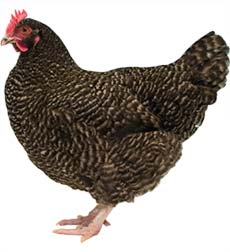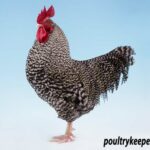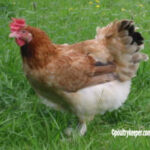
Uses: Utility. Dark egg-laying sex-linked hybrid production.
Origin: Marans, France.
Eggs: 160 – 210 Dark Brown.
Weight: Cock: 3.6 Kg. Hen: 3.2Kg.
Bantam Cock: 500 – 550g, Hen: 400 – 450g.
Colours: Black, Dark Cuckoo, Golden Cuckoo, Silver Cuckoo (Standardised), Black-Tailed Buff, Brown Red (Copper Black), Copper Blue, Silver Black (Birchen), White, Wheaten, and Columbian (Ermine) (non-standardised).
Useful to Know: Cuckoo Marans hens can be mated with an unbarred cock to produce sex-linked hybrid offspring.
The Marans was developed during the 1920s near the town of Marans, North of La Rochelle in Poitou Charente, France. The original Marans had lightly feathered legs, something that can still be seen in French birds. Many strains of Copper Black Marans (non-standard in the UK) still have reasonable amounts of feathering on the legs and are often referred to as ‘French Copper Black Marans’ because of this.
The British Poultry Standards lists feathered shanks as a serious defect. As with many utility type breeds around this time, there was great pressure to export the Marans before the type was properly fixed (which took longer due to the number of breeds that were used to create it). The original birds were producing many variations from the standard type but when it was brought to England in 1929, the type was fixed and by the mid 1930’s, the first Cuckoo Marans entered the British Poultry Standards.
The Marans are thought to be made up from quite a number of very old breeds: Barred Plymouth Rock, Coucou de Malines, Croad Langshan, and Faverolles but also some Rennes (this is a place in Brittany and thought to be a cuckoo breed), Gatinaise and possibly Brakel depending on who you speak to.
There are 4 standard colour varieties in the UK, 9 in France, and 4 in Germany. The American Poultry Association has stated that if a Marans is accepted to their standard, it will no doubt have feathered shanks and a cleaned shanked bird will not be accepted (source Marans of America Website).
Breeding hints
To improve the colour of Marans eggs, you should only select the darkest brown eggs to hatch, although I've spoken with breeders who say these are harder to hatch than lighter coloured eggs. Breeding from hens (and Cocks) that come from dark brown eggs themselves will ensure that you concentrate this gene in your strain and get more of the same thing.
Photos
Books
The following books are available. Links take you to the Amazon or other sellers’ pages for the books.
- Popular Poultry Breeds – D. Scrivener – P.125
- Storey’s Illustrated Guide to Poultry Breeds – C. Ekarius P.61
- British Poultry Standards – P.172
Breed clubs
These are the breed clubs for Marans:
- UK: The Marans Club of Great Britain
- US: Marans Chicken Club USA
- FR: The Marans Club of France
- BE: Belgium Marans Club
- DE: Marans Club of Germany
- ES: Marans Club of Spain
- AUS: French Marans Club of Australia
Further Reading
- Breeding Tips for Marans - As a utility bird, both the colour and the number of eggs are important, and it is relatively easy to select for both of these things with a little care.






















